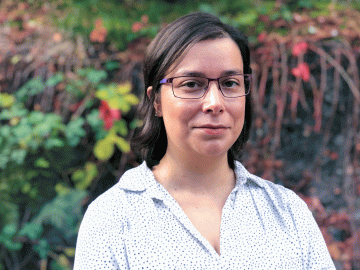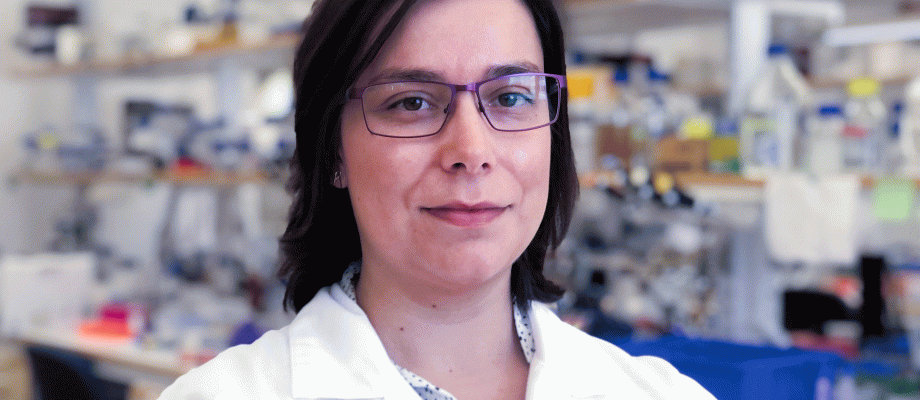YOUNG RESEARCHER. Human gut bacterium need only one of the enzymes on their surface to degrade mucins, the major component of the protective mucus layer of the colon. These surprising findings, which have been published in the journal Nature, may have significance for sufferers of inflammatory bowel disease. The article’s lead author, Ana Luis, has also just received the Large Grant from the Swedish Society for Medical Research (SSMF).
Ana Luis carried out much of the work behind the article during her postdoctoral period as a Marie Skłodowska-Curie Research Fellow at the University of Michigan Medical School. She conducted research there in Eric Marten’s laboratory, which works on understanding complex functions of the microbiota in the colon.
“A single bacterium need only one of the 28 sulfatase enzymes to degrade the mucins, the major component of protective mucus layer in the intestine,” says Ana Luis, lead author of the article in Nature. “I was very surprised when I saw the results and repeated the whole experiments several times to make sure they were right. This is the first time that a single enzyme has been shown to have an essential role on the degradation of mucins. Additionally, this is the first study ever where sulfatase enzymes have been studied in such detail.”
Failing protection in the intestine
Humans live symbiotically with the bacteria that colonize the large intestine, and the composition of the microbiota in the intestine can affect our health both positively and negatively. To avoid becoming infected by the bacteria in the intestine, cells in the intestinal wall form a protective mucus-like layer made up of mucin glycoproteins. Some gut bacteria consume the sugars found on these proteins, which causes protection of the intestinal mucosa to fail. In the Nature article, the researchers characterized twelve different enzymes (sulfatases) from the intestinal bacterium Bacteroides thetaiotaomicron. These enzymes remove blocking sugars found on mucins and, by using mucins extracted from pig colons, the authors showed for the first time that sulfatases are active on the complex sugars found on colonic mucins.
Co-authors of the article include Niclas Karlsson and Gunnar C. Hansson from the University of Gothenburg.
Possible pharmaceutical target
The new insights into how mucins in the protective mucus layer are broken down complement the picture of how bacteria normally colonize the intestine, and this new knowledge can also lead to treatments for inflammatory bowel disease. Another research team in Liverpool, in the United Kingdom, is now using the findings to try to develop a pharmaceutical that blocks the enzyme’s ability to degrade mucin glycoproteins, which may prevent the breakdown of the protective mucus layer.
Ana Luis studied pharmacy in her native Portugal and then earned a doctorate in the United Kingdom. At the last year of her PhD, she was award a prestigious Marie-Curie Global fellowship to do her postdoctoral research at the University of Michigan (United States) and The University of Gothenburg. After her fellowship, Ana continued to work as a researcher in the Mucin Biology Groups at the Institute of Biomedicine with the goal of establishing her own team in Gothenburg.
An active mucus layer
She considers the excellent collaboration among clinical and basic science researchers in Gothenburg an advantage.

“It is easy to gain access to the samples we need to study the mucus layer and microbiota in humans. The Mucin Biology groups have as outstanding research expertise and are the world-reference in the study of mucins. Here I have access to human samples and all the necessary techniques, such as in proteomics and glycomics, to study how the gut bacteria interacts with mucins. On the whole, this unique environment is perfect for conducting my research,” says Ana Luis.
Recently it has become increasingly clear that the protective mucus layer is not a passive layer of mucus; it plays an active role in selecting the bacteria that makeup the microbiota of the intestine. The protein that mainly builds up the protective mucus layer, known as mucin 2, is covered with long carbohydrate chains (glycans) that act as attachment point to the gut bacteria.
Four years of funding from SSMF
Ana Luis has just received SEK 6.8 million from the Swedish Society for Medical Research (SSMF) to continue her research into the interaction between the microbiota and the protective mucus layer during the next four years. The goal of her SSMF project is to define how the intestinal bacteria degrade mucins and how the bacteria interact with the mucus layer to colonize the intestine.
“If the composition of the intestinal flora or the carbohydrate chains on the mucins change, the risk of western diseases, such as inflammatory bowel disease and obesity, increases, but exactly how these changes cause disease is unknown. It is essential to understand how the bacteria interacts with mucins in order to identify the mechanisms that lead to western diseases”
Title: A single sulfatase is required to access colonic mucin by a gut bacterium; https://www.nature.com/articles/s41586-021-03967-5?WT.ec_id=NATURE-202110&sap-outbound-id=251BA744D339E3991A4F73CEB260C9A3BA0B5E1C
BY: ELIN LINDSTRÖM











